Ladies we Love: Mountaineer & Author Alison Levine
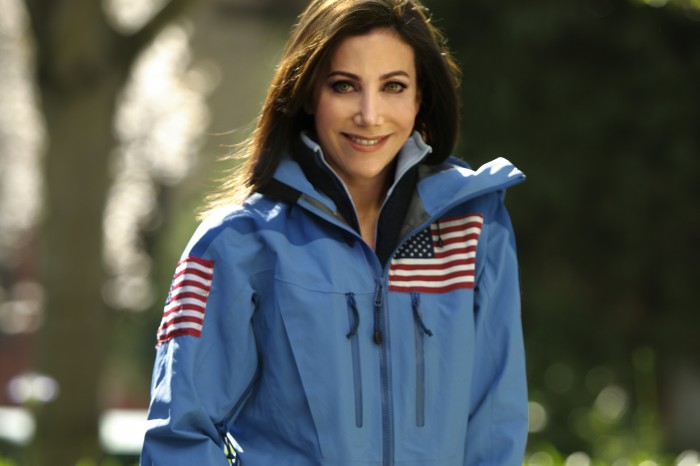
There’s a lot to say about history-making polar explorer and mountaineer Alison Levine.
She not only served as team captain of the first American Women’s Everest Expedition, but she’s also climbed the highest peak on each continent and skied to both the North and South Poles—a feat known as the Adventure Grand Slam (accomplished by fewer than forty people in the world to date).
In January 2008, Levine made history as the first American to complete a 600-mile traverse from west Antarctica to the South Pole following the route of legendary explorer Reinhold Messner. She completed this arduous journey on skis while hauling 150 pounds of her gear and supplies in a sled harnessed to her waist.
Her success in extreme environments is even more astounding when you consider the fact that she’s had three heart surgeries and suffers from Raynaud’s disease, which causes the arteries that feed her fingers and toes to collapse in cold weather—a condition that leaves her at extreme risk for frostbite.
In addition to having tackled some of the most challenging environments in the outdoors, Levine has also spent more than two decades climbing the corporate ladder, from Goldman Sachs to Arnold Schwarzenegger’s campaign team and West Point. Levine has also penned The New York Times best-seller On the Edge: The Art of High Impact Leadership (January 2014, BusinessPlus).
But what this ultra-accomplished women is most proud of is founding the Climb High Foundation, a nonprofit organization dedicated to improving the lives of jobless women in Africa by training them to be trekking guides and porters in their local mountains so that they would have the skills to earn a sustainable living wage through climbing-related tourism. Her work in Uganda is the subject of the PBS documentary Living Courageously.
Here, we check in with Levine to learn more about her dogged determination, the ice serac that nearly took her life, and her best 3 leadership tips.
WomensMovement: What truly drives you to climb, ski, and mountaineer in the world’s most dangerous environments?
Alison Levine: Besides the feeling of complete awe that overtakes me as I stare at the pure beauty of these remote destinations, I also have a deep appreciation for these places because I love to learn…and I find that these environments are the ultimate classroom.
These mountains and polar regions teach me so much about myself and about human nature. When I’m in places where I am often uncomfortable, I learn how to really dig down deep and find “that voice” in my head that tells me that I can keep going. And when I am in situations where I really have to push myself, that’s when I learn about how to be a better climber, skier, leader and teammate. And I will never be done learning.
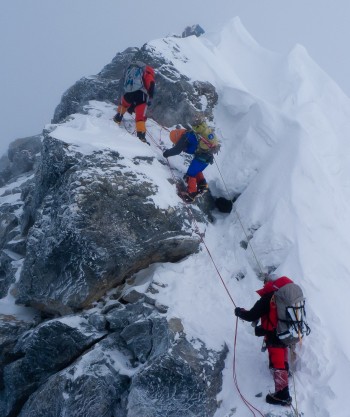
Levine on Everest’s Hillary Step. Photo: Brad Jackson
WM: What is the adventure accomplishment of which you are most proud?
Alison Levine: Oh, that’s an easy one! The adventure accomplishment I am most proud of is when I went to western Uganda and trained the first group of local women to work as trekking guides in the Rwenzori Mountains.
The Rwenzoris border Uganda and the Democratic Republic of Congo, two countries that have been at war on and off for decades, so the area had seen a lot of hardship over the years. There had been a longstanding cultural belief that it was taboo for local women to go to the mountains so prior to this climb the local women had never been permitted to climb.
Working in the mountains as trekking guides or porters is the main source of income for the men in this region, and because women were not allowed in the mountains they had no way to earn money. After much negotiating with the head of the local village, the head of the park service, and the head of the trekking service I convinced them to allow the local women to climb for the first time.
Breaking down this barrier was a huge step forward for women’s rights in this area. After our climb I returned six months later and founded an organization called the Climb High Foundation which trains jobless women to work as trekking guides and porters in the Rwenzori Mountains. This work allows them to earn a sustainable living wage and to improve their quality of life.
They have made great strides in gaining equality as a result. This is by far my greatest accomplishment and is a legacy I am really proud of.
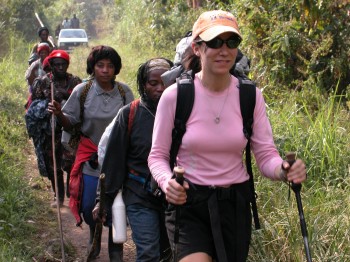
Levine training women in Uganda to climb
WM: What were 1) the most inspiring and 2) most frightening experiences when climbing Everest as the Team Captain of the first American Women’s Everest Expedition?
Alison Levine: The most inspiring part was my team. These women amazed me every day on the mountain. They had the best attitude —even when things weren’t going as smoothly as we had hoped (which happens all the time on Everest – you have to be prepared for the unexpected). Whenever one of us was feeling down, the others were right there to lend support. And when I see my team out on the slopes working hard and giving it everything they’ve got, that inspires me to give the mountain all I’ve got too.
The most frightening moment will haunt me forever. One of my teammates and I had just crossed a ladder that spanned a massive crevasse in the Khumbu Icefall (which is the most dangerous part of the mountain), and there was a huge serac that collapsed just above us and caused a massive ice avalanche. We missed being crushed by only a few feet.
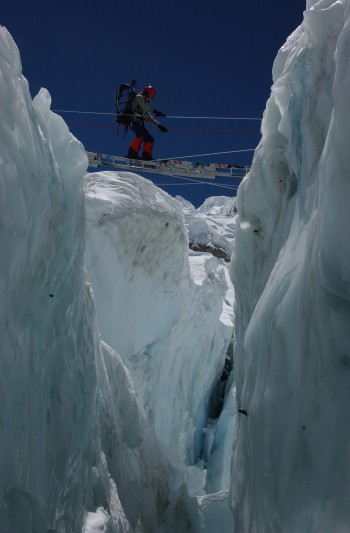
Levine crossing the Khumbu Icefall. Photo: Jake Norton
WM: How do women climb differently than men?
Alison Levine: Everyone has their own style of climbing – physically and psychologically. This may differ from person to person, but I don’t necessarily think that there is any difference between the way men and women climb.
WM: What was your most challenging expedition—and why?
Alison Levine: The most challenging was an extreme ski expedition in Antarctic. My team was skiing 600 miles across the western part of the continent to the South Pole. Even though I was as prepared as I could possibly be when I showed up for the trip (I had trained like crazy), I was the slowest, weakest member of the team, which of course did not feel good.
Part of what made the trip such a struggle for me (in addition to the sub- zero temperatures) was that we each had to drag 150 pounds of our gear and supplies in a sled harnessed to our waists. I am 5’4” tall and about 110 lbs. My teammates were much larger than me (one was 6’4” and 230 pounds) and were able to haul that heavy sled a lot more quickly and efficiently than I could. This really took a toll on me both not only physically, but also psychologically as I tossed and turned every night thinking that the team would be better off without me.
It’s a long story, but basically our brilliant team leader got creative and helped me find a way to compensate for my weakness (I wrote about this in detail in Chapter 6 of my book, which seems to be everyone’s favorite chapter). It was a great learning experience for me and taught me that if you can find a way to help a weak teammate compensate for their weakness, you’ll often get more productivity out of that person than you would have had their performance been on par with everyone else from the get-go.
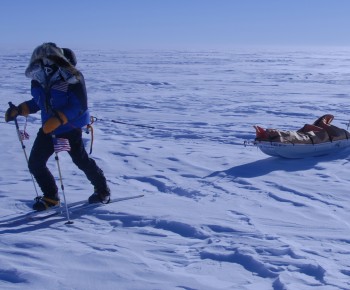
Levine hauling a sled in Antarctica. Photo: Eric Phillips
WM: How has your business background prepared you for outdoor accomplishment? Do you currently balance business with outdoor pursuits?
Alison Levine: The business world taught me one of the most important lessons for survival in the mountains: complacency will kill you. You have to be able to act and react quickly when you are in an environment that is constantly shifting and changing. Balancing business and outdoor pursuits is not easy, but I manage to do it.
Even when I am crazy busy on the speaking circuit or on book tour (which has basically been this entire year), I still make time to get out to the mountains and play. For example, I spoke at a real estate conference in Australia this past spring, and I blocked off a few extra days to go hike Mt. Kosciusko while I was there. Of course it’s not as easy to find mountains when I am speaking in places like Las Vegas and Orlando. But, next year I will take a big chunk of time off and head back out for some kind of expedition (I just haven’t decided where to go yet).
WM: We love your book, On the Edge: The Art of High-Impact Leadership. Can you give our readers 3 of your most-trusted leaderships tips that you’ve culled from your outdoor experiences?
Alison Levine: Thank you! Three leadership tips for readers:
1. Empower everyone on your team to think and act like a leader regardless of title or tenure or experience level, because everyone needs to realize that they have a responsibility to the people on either side off them.
2. Sometimes you have to toss well laid-out plans out the window and take action based on the situation at the time rather than on the plan. Plans are outdated as soon as they are finished in environments that change very rapidly (which is today’s world for sure).
3. You don’t have to be the fastest or strongest climber to get to the top; you just have to be relentless about putting one foot in front of the other. #KeepClimbing
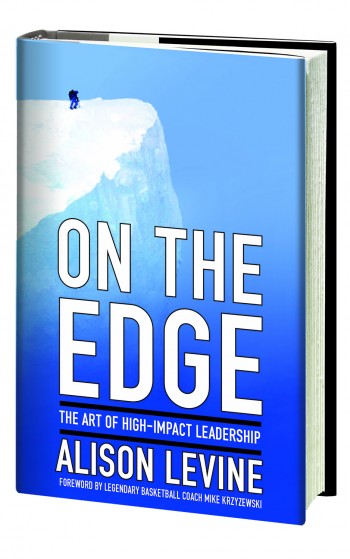
Kamagra oral jelly Online something to buy the most convenient way. He doesn’t demand from you any actions except how to visit the website. And in separate with goods necessary to you to put the end. To specify your address and to wait for the supplier to whom you will give money.


LET'S GET SOCIAL